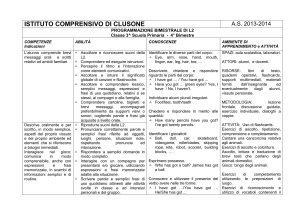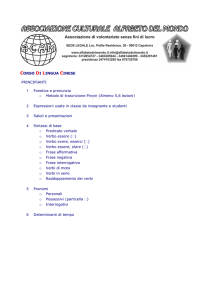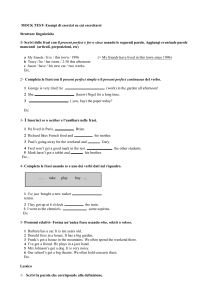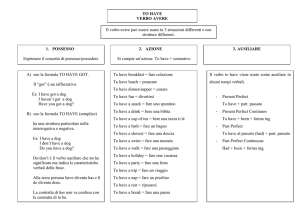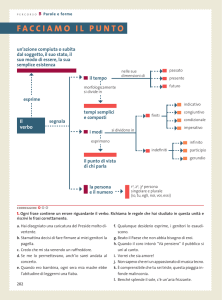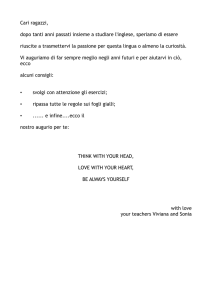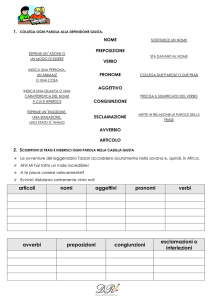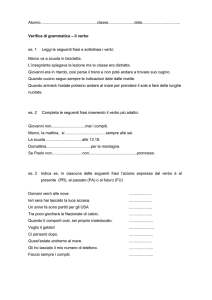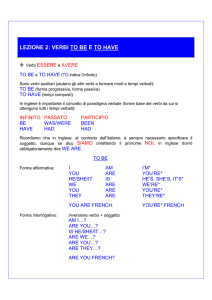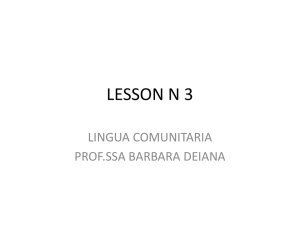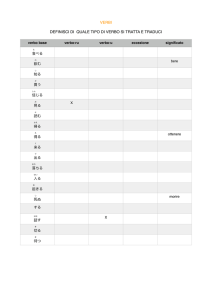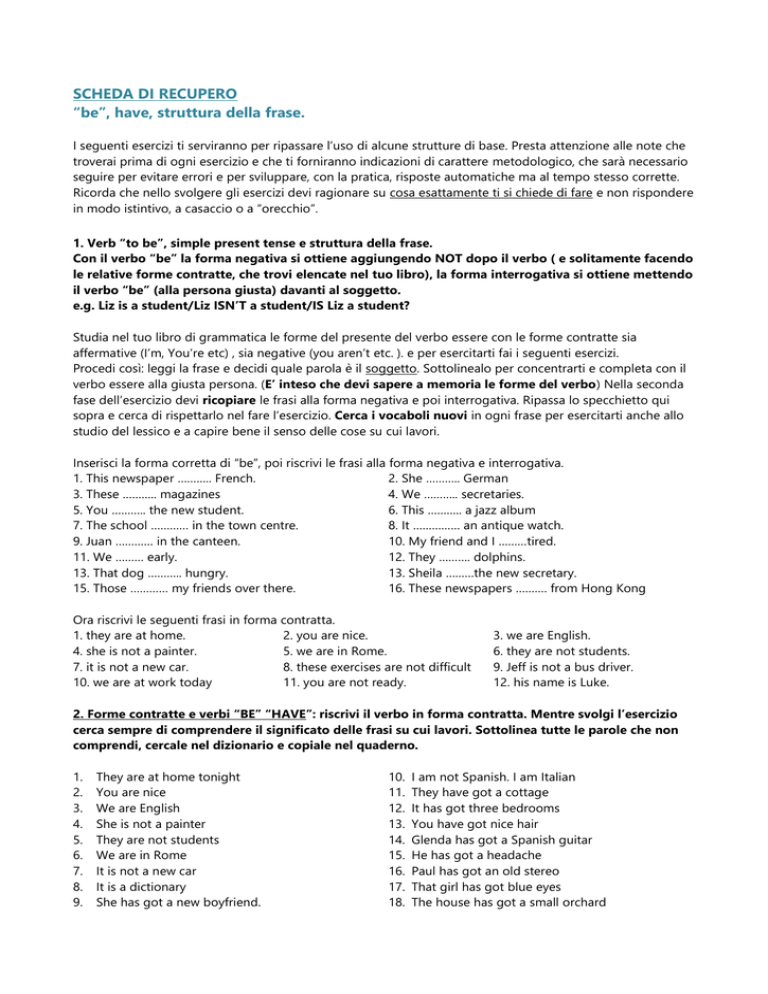
SCHEDA DI RECUPERO
“be”, have, struttura della frase.
I seguenti esercizi ti serviranno per ripassare l’uso di alcune strutture di base. Presta attenzione alle note che
troverai prima di ogni esercizio e che ti forniranno indicazioni di carattere metodologico, che sarà necessario
seguire per evitare errori e per sviluppare, con la pratica, risposte automatiche ma al tempo stesso corrette.
Ricorda che nello svolgere gli esercizi devi ragionare su cosa esattamente ti si chiede di fare e non rispondere
in modo istintivo, a casaccio o a “orecchio”.
1. Verb “to be”, simple present tense e struttura della frase.
Con il verbo “be” la forma negativa si ottiene aggiungendo NOT dopo il verbo ( e solitamente facendo
le relative forme contratte, che trovi elencate nel tuo libro), la forma interrogativa si ottiene mettendo
il verbo “be” (alla persona giusta) davanti al soggetto.
e.g. Liz is a student/Liz ISN’T a student/IS Liz a student?
Studia nel tuo libro di grammatica le forme del presente del verbo essere con le forme contratte sia
affermative (I’m, You’re etc) , sia negative (you aren’t etc. ). e per esercitarti fai i seguenti esercizi.
Procedi così: leggi la frase e decidi quale parola è il soggetto. Sottolinealo per concentrarti e completa con il
verbo essere alla giusta persona. (E’ inteso che devi sapere a memoria le forme del verbo) Nella seconda
fase dell’esercizio devi ricopiare le frasi alla forma negativa e poi interrogativa. Ripassa lo specchietto qui
sopra e cerca di rispettarlo nel fare l’esercizio. Cerca i vocaboli nuovi in ogni frase per esercitarti anche allo
studio del lessico e a capire bene il senso delle cose su cui lavori.
Inserisci la forma corretta di “be”, poi riscrivi le frasi alla forma negativa e interrogativa.
1. This newspaper ……….. French.
2. She ……….. German
3. These ……….. magazines
4. We ……….. secretaries.
5. You ……….. the new student.
6. This ……….. a jazz album
7. The school ………… in the town centre.
8. It …………… an antique watch.
9. Juan ………… in the canteen.
10. My friend and I ………tired.
11. We ……… early.
12. They ………. dolphins.
13. That dog ……….. hungry.
13. Sheila ………the new secretary.
15. Those ………… my friends over there.
16. These newspapers ………. from Hong Kong
Ora riscrivi le seguenti frasi in forma contratta.
1. they are at home.
2. you are nice.
4. she is not a painter.
5. we are in Rome.
7. it is not a new car.
8. these exercises are not difficult
10. we are at work today
11. you are not ready.
3. we are English.
6. they are not students.
9. Jeff is not a bus driver.
12. his name is Luke.
2. Forme contratte e verbi “BE” “HAVE”: riscrivi il verbo in forma contratta. Mentre svolgi l’esercizio
cerca sempre di comprendere il significato delle frasi su cui lavori. Sottolinea tutte le parole che non
comprendi, cercale nel dizionario e copiale nel quaderno.
1.
2.
3.
4.
5.
6.
7.
8.
9.
They are at home tonight
You are nice
We are English
She is not a painter
They are not students
We are in Rome
It is not a new car
It is a dictionary
She has got a new boyfriend.
10.
11.
12.
13.
14.
15.
16.
17.
18.
I am not Spanish. I am Italian
They have got a cottage
It has got three bedrooms
You have got nice hair
Glenda has got a Spanish guitar
He has got a headache
Paul has got an old stereo
That girl has got blue eyes
The house has got a small orchard
Inserisci nelle seguenti frasi il verbo appropriato. Prima di scrivere la risposta leggi TUTTA la frase e
sottolinea il SOGGETTO.
1.
2.
3.
4.
5.
……….. you thirsty? I ………… some juice fruit for
you.
Where ……… Mum?
The cottage ……….. warm in winter. It ………..
central heating.
I ………. not tired
Susan’s surname ………… Jinks
6.
7.
8.
9.
10.
11.
We ……….. in the mountains
The telephone ………. over there.
………. there any fruit?
We ……….. not hungry.
The children ………… a dog and a parrot.
Helen ……….. brown hair and blue eyes
Cos’è “ ‘s” ? Scrivi IS o HAS negli spazi.
1. She’s got friends in Rome
2. She’s very friendly
3. Simon’s a model.
He’s got fair hair and blue eyes.
5. My sister’s cold.
6. Jack’s got a new car
7. He’s got an interview tomorrow for a
new job
4. My brother’s a technician
8. Tim’s in a hurry.
3. Utilizzo del libro di testo.
Prima di fare i compiti, rileggi sempre tutto quello che è stato fatto in classe, leggi sia i libri (TUTTI) e gli
appunti sul quaderno. Poi cerca di memorizzare vocaboli ed espressioni che trovi nei testi. Per esempio,
prova a svolgere l’esercizio che trovi qui sotto. Se incontri difficoltà o commetti molti errori, significa che il
tuo studio dei testi che usi in classe non è sufficiente.
Cosa dici se:
1. Ti fanno male le dita
2. Il pasto è stato indimenticabile
3. Alla mamma non è piaciuto il suo panino
4. Vuoi sapere con chi ho cenato ieri sera
5. Vuoi sapere con chi stavo parlando quando mi hai visto ieri sera
6. Vuoi dire che il tuo amico parla molto meglio di te Inglese.
Ricordi le seguenti parole?
Leggio, sgridare, lavapiatti, gomma, navicella spaziale, seminterrato, vita sedentaria,

